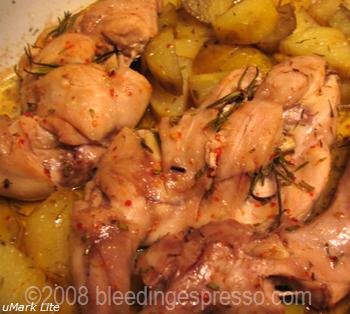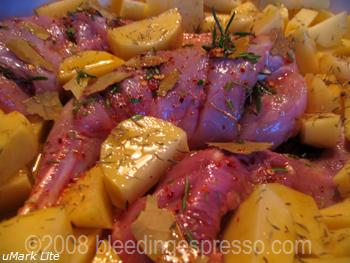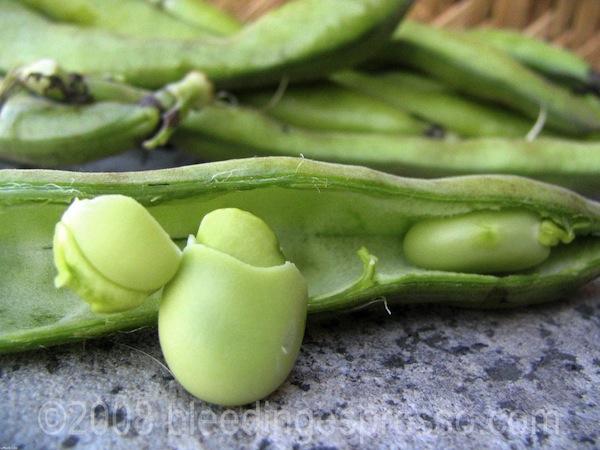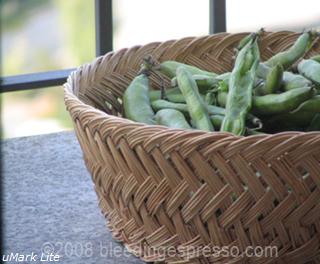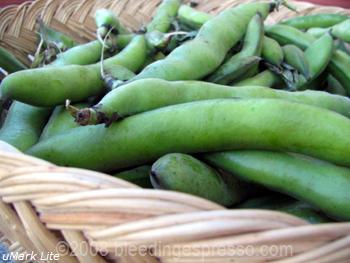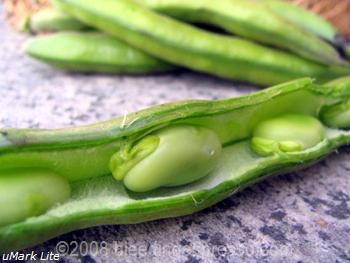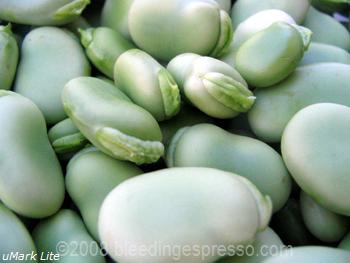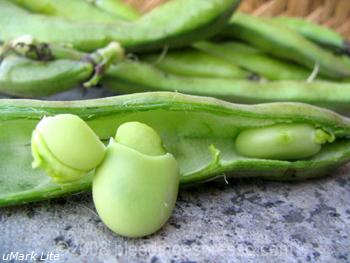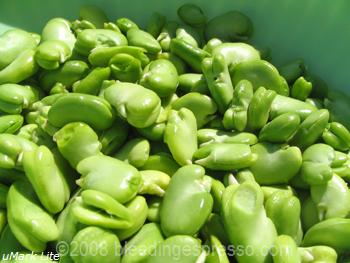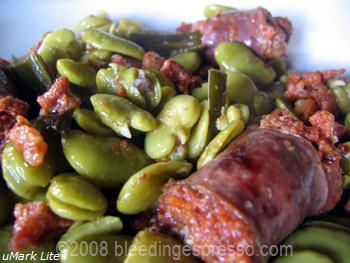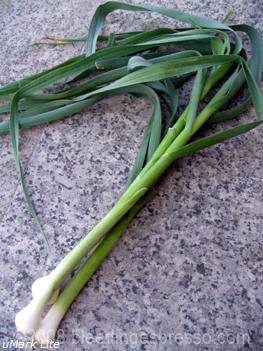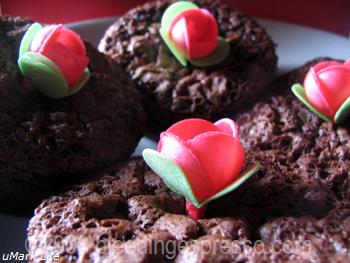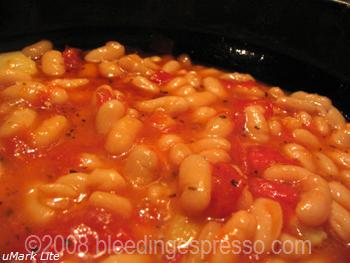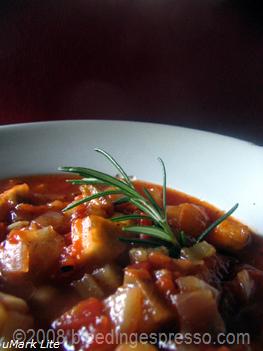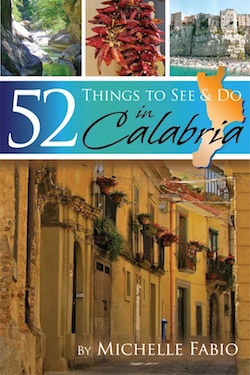Archive for the ‘what’s cooking wednesday’ Category
what’s cooking wednesday: roasted rabbit & potatoes
 We’re gonna have woast wabbit! We’re gonna have woast wabbit!
We’re gonna have woast wabbit! We’re gonna have woast wabbit!
Yes, I say this every time we make this dish, and sadly, it’s completely lost on P. So you *must* appreciate it. You do, don’t you?
Today’s What’s Cooking Wednesday recipe is fresh off the “Bizarre Foods” discussion on Friday because yes, I do realize that eating rabbit may be out of the ordinary for some of you. It wasn’t the norm for me either before I came here, although my (Italian) great-grandfather apparently made a delicious rabbit ragù for the family in America.
P’s father used to raise rabbits for food, and now since P is continuing the tradition, it’s quite common to find rabbit on our dinner table.
If you’re curious, no, I have absolutely nothing to do with raising them–we’d likely end up with a lot of pet rabbits if that were the case. And the time P asked me to help, ahem, prepare the rabbit for cooking? He quickly let me off the hook when tears welled up in my eyes at the sight of the poor thing–no longer alive, but still difficult to see.
Yes, I know you may find that hypocritical, but that’s me. I have to say that I do admire P’s compassion and caring in bringing up the rabbits though. I know that sentiment may be nonsensical to vegans, vegetarians, and others, and quite honestly, it’s hard for me to really wrap my head around as well, but it’s true.
He is quite gentle and humane with them and even gives them names; he just grew up knowing them as food, and that’s what they are for us. We definitely save money on meat purchases and at least we know that these are organically raised and treated well.
Such is life in Calabria–full of contradictions and peculiarities but never, ever, boring.
Now on to the recipe, which is based on Coniglio (o pollo) al forno con patate–that “o pollo” means you can also use this recipe for chicken.
Roasted Rabbit & Potatoes
(serves 2 as main course, more as part of larger dinner)
- 3 pieces of rabbit (2 thighs and a shoulder will do)
- 4 large potatoes, cut into chunks
- 3 cloves of garlic, cut into chunks to be inserted into rabbit pieces
- 3 tablespoons olive oil
- a few sprigs of rosemary
- thyme
- 2 bay leaves
- salt
- peperoncino
1. Turn on oven and set to 200°C (390°F).
2. In a small bowl, mix together olive oil, salt, peperoncino, and some rosemary. Let sit for about 10 minutes.
3. Wash the pieces of rabbits, and without drying, put them in baking dish.
4. Wash the potatoes, peel and cut them into chunks, and add them to baking dish; sprinkle them with salt and thyme.
5. Score rabbit so that you have places to insert garlic and some sprigs of rosemary. Brush oil mixture liberally onto rabbit pieces and then break up the bay leaves on top of the rabbit.
At this point, it should look something like this:
6. Cover baking dish with aluminum foil and place in oven.
7. Let cook for about a half hour. Remove from oven. Turn rabbit and toss potatoes. If the dish is dry on the bottom add some olive oil and/or water.
8. Cook for another 20 minutes or so, being sure that potatoes and rabbit are fully cooked before serving.
9. Let sit a few minutes before serving, but still serve hot.
Buon appetito!
What’s Cooking Wednesday: Calabrian Sausage & Fava Beans
 You had to know it was only a matter of time before fava beans made an appearance on What’s Cooking Wednesday.
You had to know it was only a matter of time before fava beans made an appearance on What’s Cooking Wednesday.
Fava beans (also known as broad beans and “fava” in Italian, “fave” is plural) are peasant food at its finest, and if there’s one thing we do well in Calabria, it’s peasant.
I wrote about favas before they start coming into season right around St. Joseph’s Day in March; now we’re at the end of the fava run. Mostly we just eat them raw as a snack (more info on how you get to that point below), but when P’s mom brought a big ole bag of them over, we had an urge to cook them.
And yes, that could also be because “Fabio” comes from faba…Latin for fava! It’s in our DNA around here.
Normally P’s mom would use “carne salata” (a very salty cured meat) with this dish, but we didn’t have any so we used spicy Calabrian sausage. Pancetta or bacon could also easily be substituted.
While researching for the post, I came across this recipe from medieval times–not only is the recipe quite similar to what P’s mom would make, there are words in there more reminiscent of Sicilian/Calabrian than standard Italian. Interesting, huh?
Before we get to the recipe, let’s get something clear before you start–you have to *really* want to eat favas to go through the work involved. Susan of Food Blogga, gives a great demonstration of shelling them here, and now a quick lesson from me.
They start looking like this:
Snap off the top of the pod and pull down so the pod splits at the seam (or otherwise twist and turn the thing until you expose the beans):
Remove the beans and throw away the pods so that you’re looking at a bunch of beans like this:
You’re not done yet! Now you have to take off the outer casing as well, otherwise you could be in for some nasty digestion issues later.
Susan recommends boiling the beans and then plunging them in ice water, but I just peeled off the little “handle” on top and then squeezed out the beans.
Now your favas are shelled and ready to eat raw or cook.
I told you. You have to want these.
If you’re in the right frame of mind, shelling favas can be an extremely relaxing experience as it was for me. Yes, my thumbs hurt a little bit afterwards, but you know what they say:
No pain, no favas.
They are worth it, I promise, especially since this recipe has only four ingredients. Easy peasy! Or, easy fava-y? And as I told P, it’s fava-loso.
OK I’ll stop now.
Calabrian sausage & fava beans
(Salsiccia calabrese con le fave)
4 tablespoons olive oil
2 links of spicy sausage, cut into chunks
4 garlic sprouts, chopped
Pile of favas
Salt to taste
1. Heat oil in medium pan and add sausage. Let cook for about 10 minutes until the sausage releases some of its fat and flavor into the oil.
2. Add garlic sprouts and beans and cook until beans are tender but not overcooked, about 15-20 minutes, testing often.
3. Adjust for salt.
4. Serve with fresh, crusty bread, and this is a delicious, hearty meal on its own.
Notes:
1. The green attached to the end of this fresh garlic is what I mean by garlic sprouts. The first time P’s mom called these “code” (COH-deh) or garlic tails, I just had to smile. Isn’t that a great name? Don’t you love Italian?
2. I think this recipe would be great with tomatoes thrown in too, but P wasn’t feeling adventurous, so we did it without. Maybe next fava season.
Buon appetito!
Have you tried fava beans?
What’s your favorite way to enjoy them?
What’s Cooking Wednesday: Gluten-Free Chocolate Coconut Muffins
 I recently came across a great looking recipe for a gluten-free chocolate cake in one of my favorite Italian magazines. I told my mom I was going to try it for a What’s Cooking Wednesday and her immediate reaction was “Why?”
I recently came across a great looking recipe for a gluten-free chocolate cake in one of my favorite Italian magazines. I told my mom I was going to try it for a What’s Cooking Wednesday and her immediate reaction was “Why?”
You see, I’m not allergic to gluten; perhaps you could tell from the amount of pasta recipes on here?
As I told my mom, though, I do have friends (and blog readers!) who have Celiac Disease. And let’s be honest: I’m getting plenty of white refined flour in my diet as it is.
Plus today is my sister-in-law’s birthday–a perfect time for some baking.
Happy Birthday N!
So I went to the store and picked up almond flour as listed in the recipe. Next to it on the shelf was coconut flour. Hmmm….
Yes, I came home with two fancy flours. Then I looked closer at the recipe. Six eggs! Goodness that’s a lot. Especially since P had just eaten two of the six I had in the fridge–and the hens wouldn’t be laying any more that day.
So I started looking around the Internet for other gluten-free chocolate cake recipes. I quickly found out that lots of eggs are quite common in gluten-free cake recipes–this one has 10! The cake looks fabulous, but I’m guessing anything with 10 eggs is going to be a little much for just P and me (especially when one of us will only eat sweets when force fed).
Then I found this recipe for Flourless Chocolate Muffins, played around with it, and came up with these:
Now I don’t mean to toot my own corno, but oh these are *so* good.
The coconut adds great texture, and they are just as moist as The Moistest Chocolate Cake in the World (probably because I borrowed the idea of using coffee in the batter).
I will definitely make these again. And again. And you guessed it–yet again.
Gluten-Free Chocolate Coconut Muffins
[makes 6 large or 12 normal size muffins]
 3 eggs
3 eggs
1 cup sugar
1/2 cup almond flour
2/3 cup coconut flour
6 tbl unsweetened cocoa powder
2 tbl vegetable oil
1 tsp baking powder*
2 tsp vanilla*
1/4 (measuring) cup or one small espresso cup of brewed espresso
[*For those in Italy, note that I used one bustina of lievito per dolci in place of baking powder and vanilla.]
1. Preheat oven to 350°F/180°C.
2. Grease 6 large muffin cups, or 12 normal muffin cups.
3. In large mixing bowl, beat together eggs and sugar with electric mixer.
4. Add vegetable oil and mix well.
5. Stir in almond flour, coconut flour, cocoa, vanilla, baking powder, and espresso, and mix gently. I did this with a silicone spatula, something like this.
6. Pour into muffin cups, filling about 3/4 full and bake until a toothpick inserted in the center comes out clean, between 25-35 minutes. (Mine took about 30 minutes.)
With a little dab of marshmallow/fluff, these reminded me so much of my beloved Mallo Cups . . . anyone else love them? Yes, I have a huge sweet tooth, why do you ask?
Buon appetito!
What’s Cooking Wednesday: Cannellini Beans & Tomatoes
 This week’s What’s Cooking Wednesday came about as a “What do we already have in the house?” dish.
This week’s What’s Cooking Wednesday came about as a “What do we already have in the house?” dish.
We had some cannellini beans that P’s mom had prepared for us (they were already soaked and cooked), and although we usually pair them with chicory, we wanted something different.
So I searched the Internet and found this recipe for the traditional Florentine Fagioli all’Uccelletto, which calls for just tomatoes, garlic, olive oil, and sage in addition to the beans. Since I didn’t have any sage, I used basil instead.
And it was delicious.
In fact, this has quickly become a staple for us–so quick and easy, and it sticks to your ribs too, especially when you pair it with fresh bread.
If you want to use dry beans, please see instructions here for soaking and cooking before you add them. I tend to use canned beans because they keep their consistency a little better when mixed with tomatoes in particular.
Cannellini Beans & Tomatoes
- 4 tablespoons olive oil
- 3 medium-sized ripe tomatoes, cut into chunks
- 3 small cloves of garlic, each cut in half
- 1 tablespoon of dry basil or a few leaves of fresh basil (adjust to taste)
- 2 (400 g) cans cannellini beans
- salt to taste
1. In medium saucepan, heat olive oil over medium heat.
2. Add tomatoes, garlic, basil, and a bit of salt, and let cook for about 15-20 minutes, stirring often with a wooden spoon. You essentially want this to become a chunky sauce. Note that if you’re really against tomato skins in this, parboil the tomatoes first and remove the skins before adding them to the pan.
3. Stir in beans and let cook for another 10 minutes or so. Remember that the beans really only need to be heated through, so be sure the tomatoes are cooked to your liking before adding the beans; otherwise you’ll end up cooking the beans too long, and they’ll get mushy.
4. Adjust for salt and serve hot with crusty bread.
Buon appetito!
What’s Cooking Wednesday: Mediterranean Eggplant Soup
 This past weekend I had some eggplants/aubergines sitting here waiting to be used.
This past weekend I had some eggplants/aubergines sitting here waiting to be used.
I thought about Pasta alla Norma, Calabrian stuffed eggplant, or eggplant balls, but decided that I really wanted some zuppa to warm me up–we had quite a chilly, windy weekend–so I went to the Interwebs to find something new.
I found this recipe for Mediterranean Eggplant Soup from Vegetarian Soups for All Seasons: Bountiful Vegan Soups and Stews for Every Time of Year by Nava Atlas.
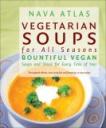 It looked fabulous, so I gave it a try, making my own adjustments, including substituting the “Italian herb mix” with a few sprigs of rosemary and thyme (and of course peperoncino) and adding a vegetable bouillon cube at the last minute for a little kick.
It looked fabulous, so I gave it a try, making my own adjustments, including substituting the “Italian herb mix” with a few sprigs of rosemary and thyme (and of course peperoncino) and adding a vegetable bouillon cube at the last minute for a little kick.
I also sprinkled some grated cheese on at the end because, well, I do that with pretty much every soup I eat.
I didn’t, however, add the small soup pasta that is called for because I really wanted to keep it light *and* I wasn’t in the mood for pasta (I know, call the authorities!).
When I make this again, I’ll add even more vegetables and make it a more general Mediterranean vegetable soup–peas, green beans, zucchini, perhaps even some cannellini beans for texture. Another idea is to throw in some shrimp and maybe a dash of Old Bay seasoning.
As you can tell, I think this is a great base for tomato vegetable soup, and all the better if you have your own stock ready. And *so* easy. Be creative!
Mediterranean Eggplant Soup
(Zuppa di Melanzane)
[adapted from Vegetarian Soups for All Seasons: Bountiful Vegan Soups and Stews for Every Time of Year by Nava Atlas]
*serves 6-8
2 tablespoons olive oil
1 large onion, chopped
2 cloves garlic, minced
2 celery stalks, diced
5 cups water
1 vegetable bouillon cube or replace one cup of water with stock
2 medium eggplants, peeled and cut into 1/2-inch dice
1 28-ounce can diced tomatoes, undrained
A few sprigs rosemary and thyme
Pinch of peperoncino
1/4 cup finely chopped fresh parsley
Salt to taste
1. Heat oil in a soup pot. Add onion, garlic, and celery and sauté over medium heat for a few minutes until onion is translucent.
2. Add water, bouillon cube, eggplant, tomatoes, rosemary, thyme, and peperoncino. Bring to a simmer and let cook until eggplant is tender, about 45 minutes.
3. Add parsley, and adjust the consistency to your liking. Season to taste with salt.
4. Grate some of your favorite cheese on top if you like, and serve immediately.
Buon appetito!

